Abstract
We examine the possibility that alternate work schedules affect perceived work-life imbalance—the “time bind.” The results show that alternate schedules per se do not “unbind” time. However, perceived control of work schedules increases work-life balance net of family and work characteristics. The most consistent family characteristic predicting imbalance is being a parent. The most consistent work characteristic predicting imbalance is hours worked. Once we control for hours worked, women and part-timers are shown to perceive more imbalance. Younger and better educated persons also perceive more work-life imbalance. However, they also report higher levels of schedule control and since schedule control improves work-life balance, it may be more important for unbinding time than schedule alternatives.
Similar content being viewed by others
References
Becker, P. E. & Moen, P. (1999). Scaling back: Dual-earner couples' work-family strategies. Journal of Marriage and the Family, 61, 995-1007.
Cohen, J. & Cohen, P. (1983). Applied multiple regression/correlation analysis for the behavioral sciences, Second Edition. Hillsdale, NJ: Lawence Erlbaum Associates.
Coser, L. & Coser, R. (1974). Greedy institutions: Patterns of undivided commitment. New York: Free Press.
Fast, J. E. & Frederick, J. A. (1996). Working arrangements and time stress. Canadian Social Trends (Winter), 14-19.
Galinsky, E., Bond, J. T. & Friedman, D. E. (1993). The changing workforce: Highlights of the national study. New York: Families and Work Institute.
Glass, J. & Camarigg, V. (1992). Gender, parenthood, and job-family compatibility. American Journal of Sociology, 98, 131-151.
Gutek, B.A., Searle, S. & Klepa, L. (1991). Rational versus gender role explanations for work-family conflict. Journal of Applied Psychology, 76, 560-568.
Hochschild, A. R. (1997). The time bind: When work becomes home and home becomes work. New York: Metropolitan Books.
Hodson, R. D. (1978). Labor in monopoly, competitive, and state sectors of production. Politics and Society, 8, 429-80.
Jacobs, J. A. & Gerson, K. (1998). Who are the overworked Americans? Review of Social Economy, 56, 442-459.
Kingston, P. W. & Nock, S. L. (1985). Consequences of the family work day. Journal of Marriage and the Family, 47, 619-29.
Kinnunen, U. & Mauno, S. (1998). Antecedents and outcomes of work-family conflict among employed women and men in Finland. Human Relations, 51, 157-77.
Milkie, M. A. & Peltola, P. A. (1999). Playing all the roles: Gender and the work-family balancing act. Journal of Marriage and the Family, 61, 476-490.
Mirowsky, J. & Ross, C. E. (1989). Social causes of psychological distress. New York: Aldine de Gruyter.
Negrey, C. (1984). Gender, time, and reduced work. Albany: State University of New York Press.
Presser, H. B. (1986). Shift work among American women and child care. Journal of Marriage and the Family, 48, 551-563.
Presser, H. B. (1995). Job, family and gender: Determinants of nonstandard work schedules among employed Americans in 1991. Demography, 32, 577-95.
Robinson, J. P. & Godbey, G. (1999). Time for life: The surprising ways Americans use their time, 2 ed. University Park: Penn State University Press.
Ross, C. E. & Sastry, J. (1999). The sense of personal control. In C. S. Aneshensel & J. Phelan (Eds.), Handbook of the sociology of mental health. New York: Kluwer Academic/Plenum Publishers.
Staines G. L. & Pleck, J. H. (1983). The impact of work schedules on the family. Ann Arbor: University of Michigan, Institute for Social Research.
Staines, G. L. & Pleck, J. H. (1986). Work schedule flexibility and family life. Journal of Occupational Behaviour, 7, 147-153.
Tilly, C. (1996). Half a job: Bad and good part-time jobs in a changing labor market. Philadelphia: Temple University Press.
U.S. Bureau of Labor Statistics. (1998). Workers on flexible and shift work in 1997. U.S. Department of Labor Report 98-119. Washington D.C.: Bureau of Labor Statistics.
Voydanoff, P. (1988). Work role characteristics, family structure demands, and work/family conflict. Journal of Marriage and the Family, 50, 749-761.
White, L. & Keith, B. (1990). The effect of shift work on the quality and stability of marital relations. Journal of Marriage and the Family, 52, 453-462.
Author information
Authors and Affiliations
Rights and permissions
About this article
Cite this article
Tausig, M., Fenwick, R. Unbinding Time: Alternate Work Schedules and Work-Life Balance. Journal of Family and Economic Issues 22, 101–119 (2001). https://doi.org/10.1023/A:1016626028720
Issue Date:
DOI: https://doi.org/10.1023/A:1016626028720




